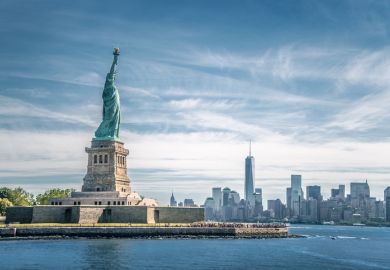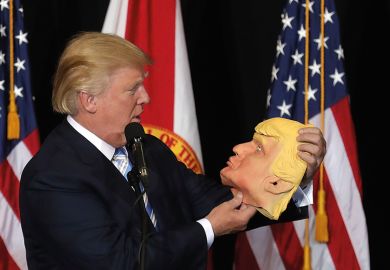The number of new international students enrolling in US universities has declined by 7 per cent in the past year, according to a snapshot study by the Institute of International Education (IIE).
A survey of 522 colleges and universities in the US found that almost half of institutions (45 per cent) reported a drop in new international student numbers for the 2017-18 academic year, while 31 per cent recorded an increase and 24 per cent held steady.
Universities cited a mix of factors for the overall 7 per cent drop in new overseas enrolments, including an uncertain US social and political climate, visa delays or denials, competition from other countries and the cost of study in the US. The data represent the first international student enrolment figures since Donald Trump was elected US president last year.
Last week, reports suggested that the UK’s home secretary, Amber Rudd, was leading a Cabinet push for international students to be removed from the government’s target to reduce net migration. Should that happen, the UK could see a rise in overseas student numbers, increasing the pressure on the US.
Overall, the majority of institutions (52 per cent) in the IIE survey expressed concern that the country’s social and political climate could deter prospective international students. A fifth of institutions (20 per cent) indicated that some of their international students have already expressed a desire to leave or have left the US because of the current climate, according to the Fall 2017 International Student Enrollment Snapshot Survey, which was conducted in September and October 2017.
Rajika Bhandari, head of research, policy and practice at the IIE, said that concerns around an “uncertain US social and political climate” included worries about the president’s travel bans as well as fears for the personal safety of international students.
Respondents also expressed concerns about recruiting students from the Middle East and North Africa and Asia for autumn 2018. In particular, they cited as worries adjustments in the Saudi Arabian government’s scholarship programme and travel restrictions to the US.
The survey, which was led by the institute in partnership with nine other higher education associations, follows a study published by the IIE in July that found that 48 per cent of US universities had seen a smaller proportion of international students accepting undergraduate admission offers ahead of the current academic year.
Allan Goodman, IIE president, said that for the first time this year “we are noticing that there are 10 to 12 countries that are really competing for the international student market with the US”.
Rival nations have set targets to boost international student numbers, “and I think we’re increasingly going to see competition as a factor in this mix, more than we have before”, he said.
The IIE cited the UK, Canada, Germany and Australia as the main sources of competition.
The autumn 2017 survey was published alongside the IIE’s Open Doors 2017 report, which was based on responses from more than 2,000 US universities and colleges and is designed to provide a more comprehensive picture of international student enrolment trends from the 2016-17 academic year.
The Open Doors survey found that the number of new international students – those who enrolled at a US institution for the first time in autumn 2016 – declined by 3 per cent to 291,000. This marks the first drop in the six years since the study has reported new enrolments.
This was largely attributable to a 14 per cent slide in the number of students enrolled in non-degree programmes, including short-term exchanges and intensive English-language programmes.
Part of that decline results from falls in the number of students from two of the top 10 largest senders of overseas students: Saudi Arabia (14 per cent decline) and Brazil (32 per cent decline).
The scaling-back of large government scholarship programmes in both countries was a significant factor, according to the IIE.
Overall, the number of international students in the US rose by 3 per cent between 2015-16 and 2016-17 to 1.08 million, but this represents the smallest rate of growth since 2009-10.
Dr Bhandari said that the rise was “primarily due to international students staying in the US longer…to gain practical work experience after graduation”.
Open Doors 2017: top places of origin of international students in the US
| Country | 2015-16 | 2016-17 | % of total | % change | |
| 1 | China | 328,547 | 350,755 | 32.5 | 6.8 |
| 2 | India | 165,918 | 186,267 | 17.3 | 12.3 |
| 3 | South Korea | 61,007 | 58,663 | 5.4 | −3.8 |
| 4 | Saudi Arabia | 61,287 | 52,611 | 4.9 | −14.2 |
| 5 | Canada | 26,973 | 27,065 | 2.5 | 0.3 |
| 6 | Vietnam | 21,403 | 22,438 | 2.1 | 4.8 |
| 7 | Taiwan | 21,127 | 21,516 | 2.0 | 1.8 |
| 8 | Japan | 19,060 | 18,780 | 1.7 | −1.5 |
| 9 | Mexico | 16,733 | 16,835 | 1.6 | 0.6 |
| 10 | Brazil | 19,370 | 13,089 | 1.2 | −32.4 |
| 11 | Iran | 12,269 | 12,643 | 1.2 | 3.0 |
| 12 | Nigeria | 10,674 | 11,710 | 1.1 | 9.7 |
| 13 | Nepal | 9,662 | 11,607 | 1.1 | 20.1 |
| 14 | United Kingdom | 11,599 | 11,489 | 1.1 | −0.9 |
| 15 | Turkey | 10,691 | 10,586 | 1.0 | −1.0 |
| World total | 1,043,839 | 1,078,822 | 3.4 | ||
Register to continue
Why register?
- Registration is free and only takes a moment
- Once registered, you can read 3 articles a month
- Sign up for our newsletter
Subscribe
Or subscribe for unlimited access to:
- Unlimited access to news, views, insights & reviews
- Digital editions
- Digital access to THE’s university and college rankings analysis
Already registered or a current subscriber?








